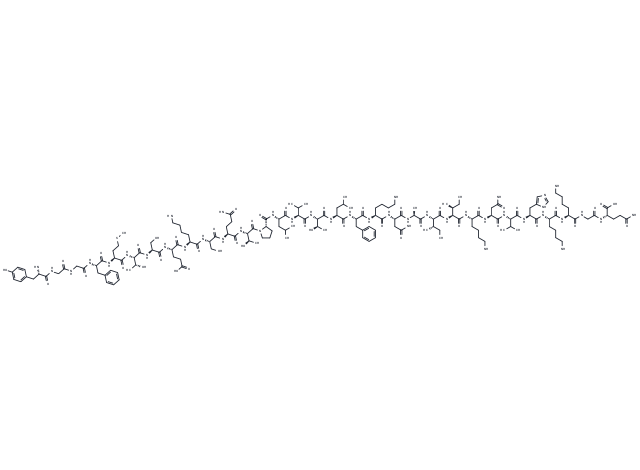Shopping Cart
- Remove All
 Your shopping cart is currently empty
Your shopping cart is currently empty

β-Endorphin (β-EP) is an endogenous opioid neuropeptide with diverse biological activities. It is produced via piomelanocortin cleavage in the pituitary gland, hypothalamus, and in lymphocytes, then migrates to its sites of action which include plasma, gut, skin, placenta, cerebrospinal fluid, and cardiac tissues. β-EP induces concentration-dependent decreases in electrically stimulated contraction of the mouse vas deferens that can be reversed by the μ-opioid antagonist CTP and δ-opioid antagonist ICI 174,864.

| Pack Size | Price | Availability | Quantity |
|---|---|---|---|
| 1 mg | Inquiry | Backorder |
| Description | β-Endorphin (β-EP) is an endogenous opioid neuropeptide with diverse biological activities. It is produced via piomelanocortin cleavage in the pituitary gland, hypothalamus, and in lymphocytes, then migrates to its sites of action which include plasma, gut, skin, placenta, cerebrospinal fluid, and cardiac tissues. β-EP induces concentration-dependent decreases in electrically stimulated contraction of the mouse vas deferens that can be reversed by the μ-opioid antagonist CTP and δ-opioid antagonist ICI 174,864. In vivo, β-EP (5 μg, i.c.v.) slows gastrointestinal transit in mice. β-EP (0.5 or 5 μg, i.c.v.) stimulates food intake in rats for 4 to 6 hours, however, this effect is not prolonged with continuous infusion. It antagonizes the appetite-suppressive effects of α-melanocyte-stimulating hormone (α-MSH) for the first three days post administration. β-EP also reduces paralytic demyelination induced by the murine coronavirus MHV-JHM in immunocompetent, but not irradiated or immune-incompetent, mice and rats. |
| In vivo | In vivo, β-EP (5 μg, i.c.v.) slows gastrointestinal transit in mice. β-EP (0.5 or 5 μg, i.c.v.) stimulates food intake in rats for 4 to 6 hours, however, this effect is not prolonged with continuous infusion. It antagonizes the appetite-suppressive effects of α-melanocyte-stimulating hormone (α-MSH) for the first three days post administration. β-EP also reduces paralytic demyelination induced by the murine coronavirus MHV-JHM in immunocompetent, but not irradiated or immune-incompetent, mice and rats. |
| Molecular Weight | 3466.07 |
| Formula | C157H254N42O44S |
| Cas No. | 309246-19-3 |
| Storage | keep away from moisture | Powder: -20°C for 3 years | In solvent: -80°C for 1 year | Shipping with blue ice. |
| Solubility Information | H2O: 1 mg/mL (0.29 mM), Sonication is recommended. |

Copyright © 2015-2025 TargetMol Chemicals Inc. All Rights Reserved.